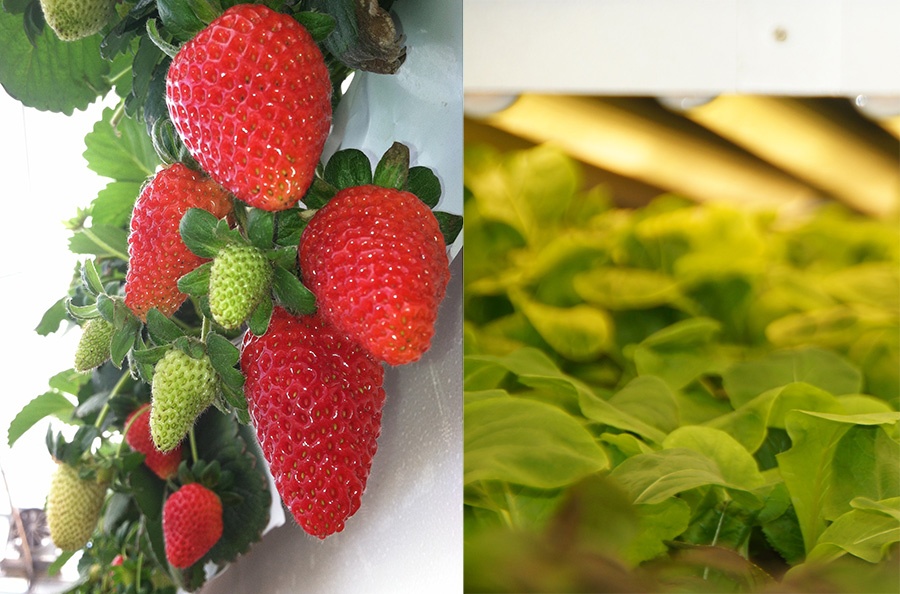
Grow lights are major focus of Cultivate’19 educational sessions



This article was originally posted on currentbyge.com
Stan Gordon discovered the ultimate houseplant in 1986 when a friend gifted him a single orchid commemorating the birth of his daughter. Fast-forward 33 years, and Gordon finds himself surrounded by over 70,000 orchid plants in a 10,000-square-foot greenhouse in Louisville, Colorado. Business is always “blooming” at Fantasy Orchids with an ever-changing assortment of colorful, fragrant flowers, thanks in part to new LED lighting from Current, powered by GE, that makes growing season a year-round proposition.
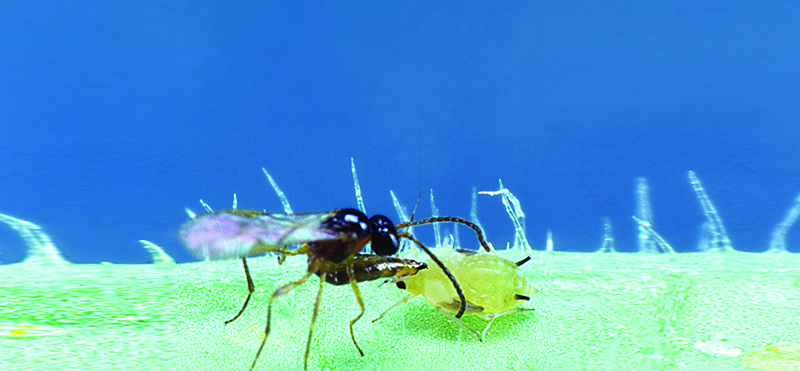
While maintaining the proper temperature and humidity is important to ensure the optimum growing conditions for controlled environment agriculture, these environmental factors become even more important when using biological controls.
Continue reading How can sensors increase efficiency, effectiveness of your IPM strategies?
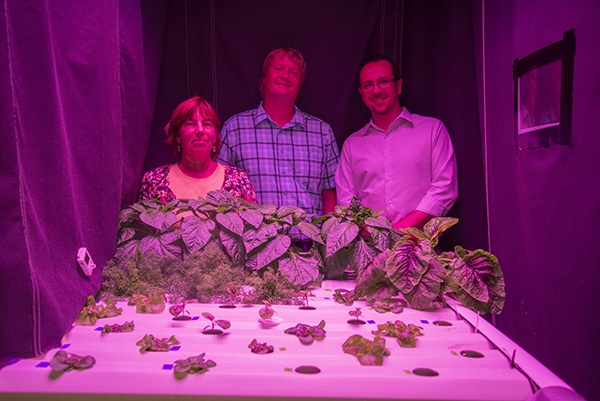
Continue reading GLASE consortium aims to improve greenhouse energy efficiency

 |
| University of Arizona Controlled Environment Agriculture Center will host the 14th annual Greenhouse Crop Production & Engineering Design Short Course, March 22–27, 2015. |
 |
| A day of hands-on workshops during the Greenhouse Crop Production & Engineering Design Short Course will cover a variety of topics including growing lettuce and herbs in floating systems. |
Visit our corporate website at https://hortamericas.com
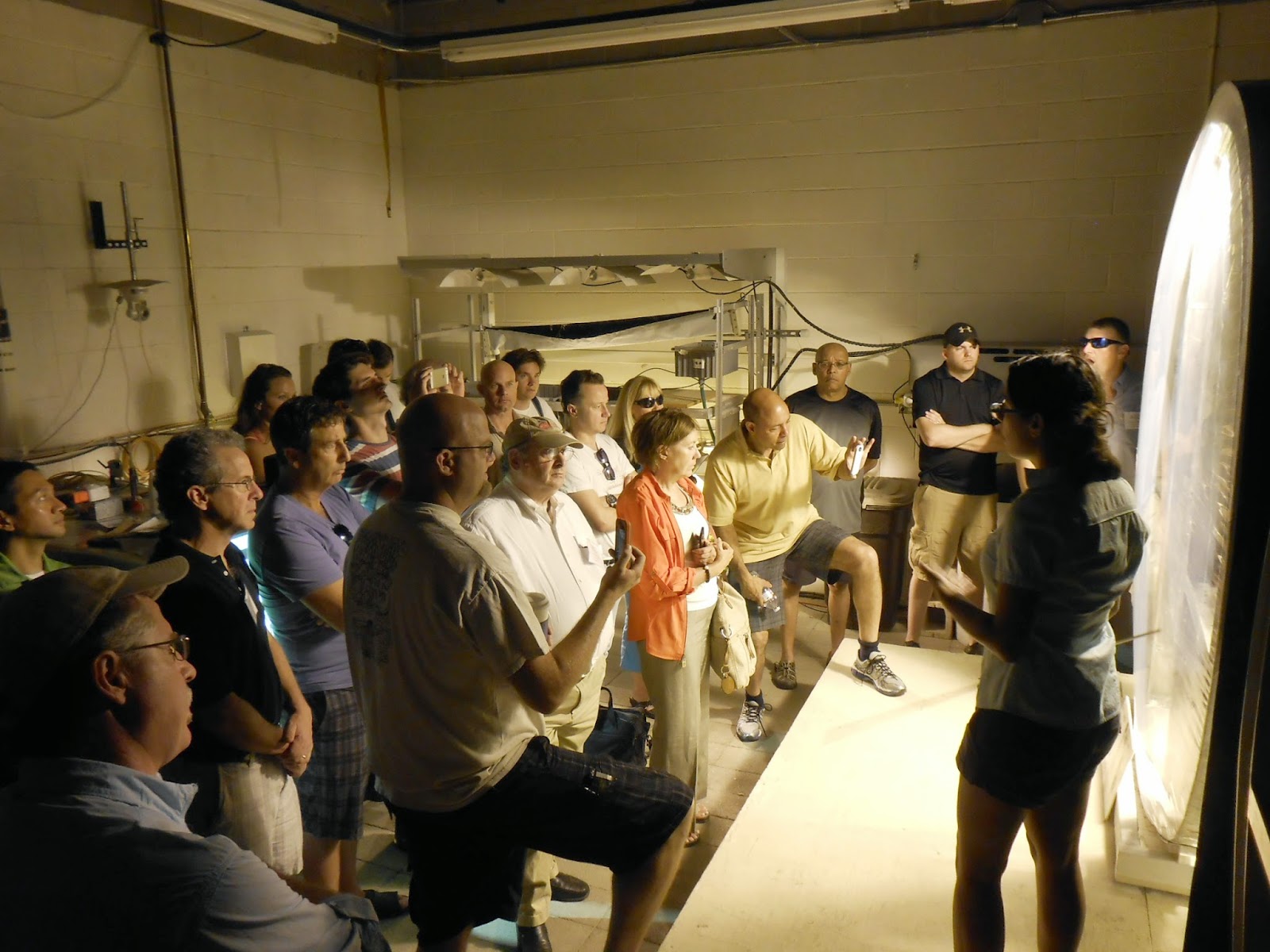
Attendees at the first “Realities of Growing Plants
Indoors” Short Course learned what it takes culturally to produce controlled
environment crops as well as how to finance and market their businesses.
“The grower-focused presentations had an emphasis on
indoor production, which included greenhouses and also closed environments such
as vertical farming,” Giacomelli said. “Topics included irrigation, climate
control and lighting. We gave them some applied horticultural information that
they should at least be aware of and then learn more about if they want to get
into this business and grow indoors.”
During the last half of the second day the Short Course
transitioned to the business side.
 |
| Members of a business forum panel who spoke to Short Course attendees included a produce distributor, two entrepreneurs who started their own indoor food production companies, a regional buyer for a national grocery store chain and a philanthropist investor. |
“By bringing the two groups together we tried to give
those growers and would-be-growers who are considering starting a horticultural
business a chance to hear from those people who could provide them with a
reality check,” Giacomelli said.
For more: Gene
Giacomelli, University of Arizona, Ag & Biosystems Engineering Department,
Controlled Environment Agriculture Center; (520) 626-9566;
giacomel@ag.arizona.edu; http://ag.arizona.edu/ceac.
Visit our corporate website at https://hortamericas.com

Visit our corporate website at https://hortamericas.com
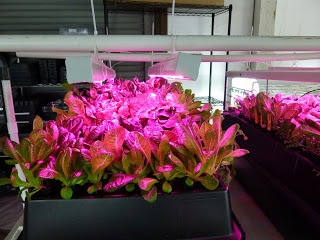
Experiment information provided by Patty Phaneuf from Specialty Greens, and Posted by Maria Luitjohan from Hort Americas.
Visit our corporate website at https://hortamericas.com

2.) Would two lights per hydroponic unit (ez clone
cloner) achieve this goal or are three necessary?
Experiment under lights began: 9/26/13
Initial recommendation to hang lights 16-18” above plants produced
leggy and weak seedlings. Lights
remounted above plants 7-8” Philips GreenPower Production Modules are being run
14 hours/day. Ambient room temperature
ranges from 70 degrees during the night to 85 degrees during the day. The
nutrient used is DynaGrow at a dilution of 1/2 teaspoon per gallon so about 5-6
teaspoons per cloner. ProTect, an auxiliary nutrient, was used at the same
dilution. An ArtDne recycling timer is being used 24 hours per day at a rate of
1 minute on for every 5 minutes off. There will be one nutrient change during
the experiment after approximately two weeks to refresh the set up and new
nutrient will be applied at the dilution described above.
Specialty Greens is providing growers interested in hydroponics all the they need to grow hydroponically in a 2 ft sq. space!
To
find out more about Specialty Greens Check them out here or like them on Facebook
Here are some photos taken of the Experiment on 9/26/13
Experiment information provided by Patty Phaneuf from Specialty Greens, and Posted by Maria Luitjohan from Hort Americas.
Visit our corporate website at https://hortamericas.com
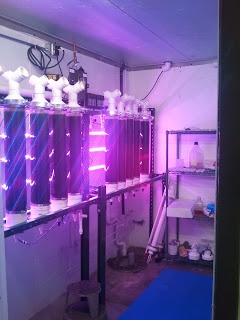
By David Kuack
Algae are considered a nuisance by commercial greenhouse growers. The warm, moist conditions that occur in greenhouses provide the ideal environment for algae growth.
Algae can be found anywhere these conditions exist, including floors, walkways, under and on benches, on greenhouse glazings and walls, in irrigation pipes and emitters and misting lines, on the surface of evaporative cooling pads and on the surface of growing media in containers and ground beds. Algae can also be a food source for fungus gnats and shore flies. But algae also hold great potential in the production of value-added products.
Even though algae are a problem for growers, these simple green plants hold great potential in the production of biofuels, fertilizers, cosmetics, fish and animal feed and other value-added products. Members of the algae program at the University of Kentucky in Lexington are looking at the potential of algae production to help lower the emission of greenhouse gases, primarily carbon dioxide, from the burning of fossil fuels, particularly coal.
Andy Placido, an engineer associate with the university’s Center for Applied Energy Research, said the restrictions on greenhouse gas emissions will only increase as environmental issues gain in importance among the public and government and regulatory officials.
“Kentucky’s Department of Energy Development and Independence is always looking for ways to make coal cleaner because it is a big part of the state’s economy,” said Placido. “State officials know that there is eventually going to be some type of restrictions or tax on greenhouse gas emissions. Coal produces more carbon dioxide per energy unit than natural gas and other fuels. So officials are trying to evaluate the technology that is available to reduce greenhouse gas emissions.”
 |
| This culture closet is equipped with LED lights and temperature control. It is used to grow algae from a few milliliters up to 15-20 liters. The algae is then moved into a greenhouse for further production under higher light levels and warmer temperatures. |
An ample source of carbon dioxide
While most coal-burning power plants in Kentucky have been equipped with scrubbers to remove sulfur dioxide and nitrogen oxides, Placido said little has been done to restrict the amount of carbon dioxide that is generated in the flue gas.
“We are going to be using post-scrubbed flue gas, which is going to contain about 12 percent carbon dioxide and not a whole lot more,” he said. “There is a minimal amount of sulfur and nitrogen. That is the reason we are looking at using the carbon dioxide because there aren’t any mature technologies for the capture of this gas. Right now, we are basically following the same route that occurred during the 1980s when these power plants were looking for the technology to capture the sulfur and nitrogen.”
If the research is successful in capturing and using the carbon dioxide, there is the potential to use some of the sulfur and nitrogen currently being removed from the flue gas by the scrubbers.
“We know that algae use sulfur and nitrogen in addition to carbon dioxide,” he said. “Algae might eventually allow for the scrubbers to be eliminated altogether.”
LED lights and a greenhouse
Placido said the algae culturing system starts in the laboratory where the algae are allowed to multiply.
“We work with the university’s Department of Biosystems and Agricultural Engineering which maintains the algae strains in beakers,” he said. “The algae are purchased in small vials and then cultured up to a few hundred milliliters.”
Placido said this is when he and the other researchers start to work with the algae in an in-house designed culture closet equipped with Philips LED lights.
“We are growing algae indoors with temperature control,” he said. “We are starting to bubble in 5 percent carbon dioxide to allow the algae to acclimate to a higher percentage of carbon dioxide along with the LED lighting as we prepare to move the algae into the sunlight. When there is enough algae that have acclimated (0.05-0.1 gram of algae per liter of water), they will be taken from the culture closet to the greenhouse. In the greenhouse, it will still be a temperature-controlled environment. We’ll allow the algae to grow in the greenhouse and once they become accustomed to the higher light levels and change in temperature, we will take the algae out to the power plant where it will be exposed to outdoor conditions along with the flue gas. That is our algae process chain.”
Maximizing algae growth
LED lights are being used 24 hours a day in the culture room to provide constant light. Placido said they are also looking at using the LEDs outside as a supplement at night and possibly during winter at the power plant so the algae continue to grow.
“During the night algae start to respire during which they release carbon dioxide and take in oxygen,” he said. “This is the reverse process of what happens during the day. By using the LEDs we can keep the algae growing for 24 hours or at least reduce the respiration process. Because the LEDs are very efficient, we expect more algae will be produced than the energy needed to operate the lights.”
Placido said algae split when they grow so production is judged on doubling time. Under optimum light and temperatures in the lab a doubling time of 12-24 hours is achievable.
“With the outdoor conditions we will have with the flue gas, we are hoping to have a doubling time of two to three days,” he said. “We would like to increase the growth rate, but that is going to take some nutrient work along with optimizing the light and temperature levels. Outside we’re at the mercy of Mother Nature.”
Placido said algae growth is much better with the LEDs in a controlled environment than outside under natural conditions. He said the difference in growth comparing inside and outdoor conditions has not been quantified.
“We have gotten much greater algae growth rates inside in the culture closet equipped with LEDs than outside or in the greenhouse even under the best days in regards to light and temperature,” he said.
 |
| Algae is produced in photo-reactors that can be placed inside or outside of a greenhouse. The ultimate goal is to build a large reactor adjacent to a coal-burning power plant that will use the carbon dioxide given off in the plant’s flue gas. |
Real world use
Placido said when the system is set up at the power plant, more flue gas will be produced than can be used to grow the algae. The flue gas will be pulled into the photo-reactor, which is a series of glass tubes on a steel frame, as carbon dioxide gas is needed.
“Once the system is saturated with carbon dioxide, the algae will be allowed to grow and then will be harvested. More carbon dioxide will be added as it is needed,” he said. “We know that our reactor isn’t nearly big enough to capture all of the carbon dioxide. The reactor we are using only holds about 2,000 gallons of water. That’s a good size, but nowhere near the size we would need to capture all of the carbon dioxide. We have estimated to capture all of the carbon dioxide from this one power plant would require a reactor that would cover 100 acres and take millions of gallons of water.
Placido said the power plant can provide an unlimited amount of steam to keep the water in the reactor tubes from freezing during the winter.
“During the winter with the sun’s heat during day the water temperature would stay above freezing,” he said. “With the steam from the power plant to heat the water along with keeping the water circulating continuously, that should be enough to keep the system from freezing. Then we would supplement the natural light with the LEDs if it was needed.”
Grower potential
Placido said there are some possibilities for commercial growers to produce algae and use algae in the future.
“That is our goal, to find out how we can improve the process for making fuel and how does that compare with other algae-derived products, such as fertilizers, animal feed, etc.,” he said. “Our end goal is to make biofuel. In the future the ideal situation would be for growers to produce their own energy source.”
For more: Andy Placido is Engineer Associate II, University of Kentucky, Center for Applied Energy Research, (859) 257-0223; andy.placido@uky.edu.
David Kuack is a freelance technical writer in Fort Worth, Texas, dkuack@gmail.com.
Visit our corporate website at https://hortamericas.com
Hort Americas has been extremely busy leading up to the Thanksgiving Holiday Weekend. And lets just say its the good busy, the fun busy!
Last night we shot our first video which will ultimately become a series of educational and information videos geared towards the commercial horticulture and hydroponic industry. The first video will focus in on the Philips GreenPower LED Production Module and its possible application in the production of ornamental and hydroponic crops.
 |
|
| The New Videos will focus on LED Grow Lights and will star Ms. Abigail Herring! |
Hort Americas is also and excited and proud to be working with many of the industry’s top editors. We are dedicated and focused on helping to build the industry, which makes us thankful (since it is Thanksgiving) for the work of individuals like Annie White of Ball Publishing. See a sample of Annie’s work here.
Happy Thanksgiving everyone!
Visit our corporate website at https://hortamericas.com
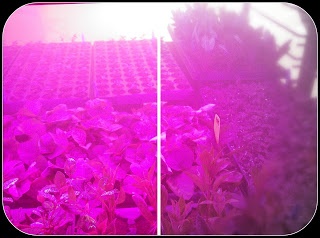
 |
| Crops on Cannon carts under fog and Philips LED Grow Lights |
 |
| Finished crop on Cannon carts (multilayer production) under LED grow lights |